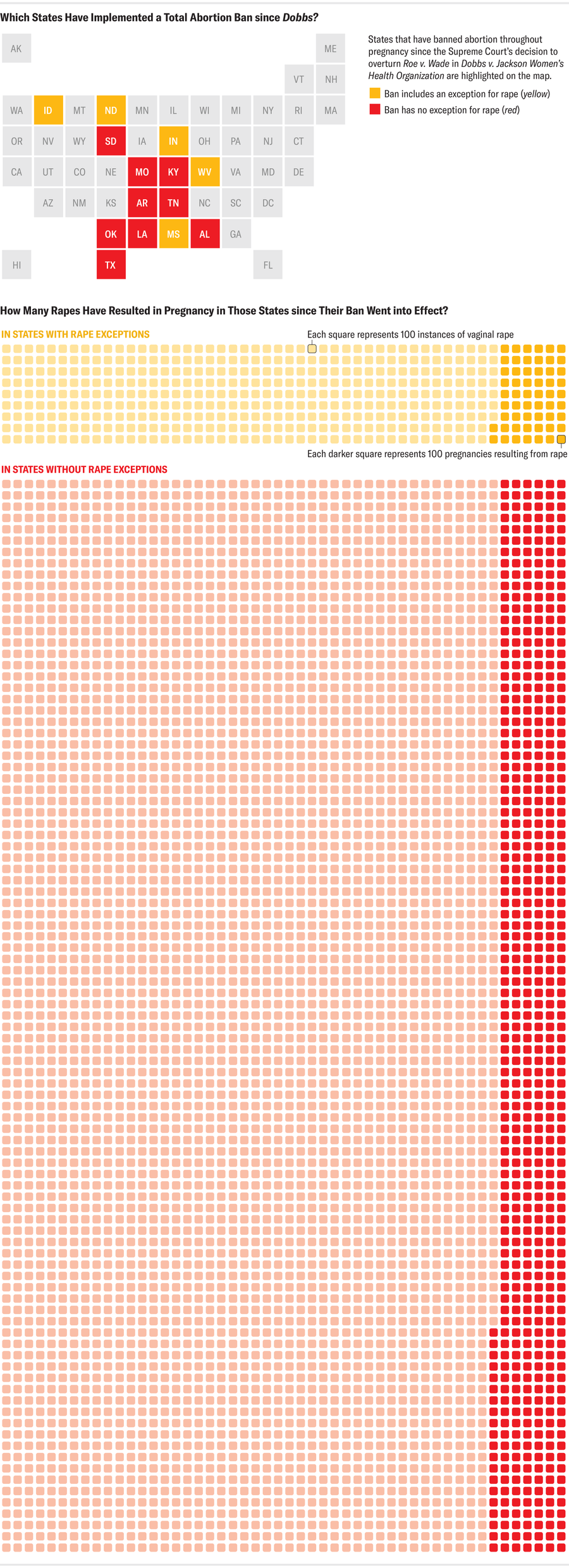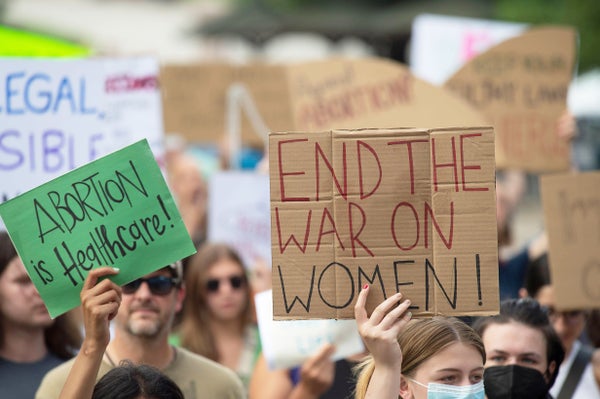After the U.S. Supreme Court overturned Roe v. Wade in Dobbs v. Jackson Women’s Health Organization in 2022, total abortion bans went into effect in 14 states. Nine of these have no exceptions for rape. Now researchers have attempted to quantify the number of pregnancies that have resulted from rapes in states with a total ban—and the numbers they came up with are staggering.
A new study estimates that more than 64,000 pregnancies resulted from rape between July 1, 2022, and January 1, 2024, in states where abortion has been banned throughout pregnancy in all or most cases. Of these, just more than 5,500 are estimated to have occurred in states with rape exceptions—and nearly 59,000 are estimated for states without exceptions. The authors calculate that more than 26,000 rape-caused pregnancies may have taken place in Texas alone. The findings were published on Wednesday in JAMA Internal Medicine.
“Highly stigmatized life events are hard to measure. And many survivors of sexual violence do not want to disclose that they went through this incredibly stigmatizing traumatic life event,” says Samuel Dickman, chief medical officer at Planned Parenthood of Montana, who led the study. “We will never know the true number of survivors of rape and sexual assault in the U.S.”
On supporting science journalism
If you're enjoying this article, consider supporting our award-winning journalism by subscribing. By purchasing a subscription you are helping to ensure the future of impactful stories about the discoveries and ideas shaping our world today.

The researchers obtained their findings by combining data from multiple sources. Because state-level data weren’t available, the team analyzed national data from a U.S. Centers for Disease Control and Prevention survey on intimate partner sexual violence from 2016 to 2017. The researchers also used a Bureau of Justice Statistics survey on criminal victimization. Putting these together, they determined the number of completed vaginal rapes among girls and women of reproductive age—defined as between the ages of 15 and 45 (although some even younger girls and older women are also capable of pregnancy).
The authors generated state-level rape estimates by partitioning the national data according to state-level information from FBI crime reports, which included rapes that were reported to police in 2019. (A high percentage of rapes are never reported to authorities, but the CDC survey attempted to correct for this.) The researchers then calculated the number of state-level rapes that were likely to result in a pregnancy, controlling for the number of months that a total abortion ban was in effect.
The findings suggest that thousands of people who were raped became pregnant in states where abortion was banned. Even in states with exceptions for rape, very few people got an abortion—likely because of fear and intimidation, Dickman speculates. Some pregnant people in states with bans may have traveled out of state to obtain an abortion legally, but some would have needed to travel hundreds of miles—a journey that is impractical or impossible for many people.
The authors acknowledge that their study has some limitations. Their numbers are based on rape data from national surveys that they extrapolated to the state level, based on rates of reported rapes, and the study assumes that these reporting rates are similar among states. Accurate data on rapes and sexual assaults are always hard to obtain because stigma prevents many people from reporting them. As noted, the CDC survey attempted to account for this underreporting in its data, but other sources suggest the rates of rape and sexual assault may be higher or lower, Dickman says.
“The study demonstrates there are a lot of pregnancies that occur after rapes in states where there are abortion bans,” says Amanda Stevenson, an assistant professor of sociology at the University of Colorado Boulder, who studies abortion and family planning policy but was not involved in the work. Stevenson acknowledges that the authors had to make a lot of assumptions to arrive at their estimates. These assumptions are necessary, however, given the inherent uncertainty around data on rape and conception rates, she adds. “The precise estimate is much less important to me ... than the fact that the number is large,” Stevenson says.
